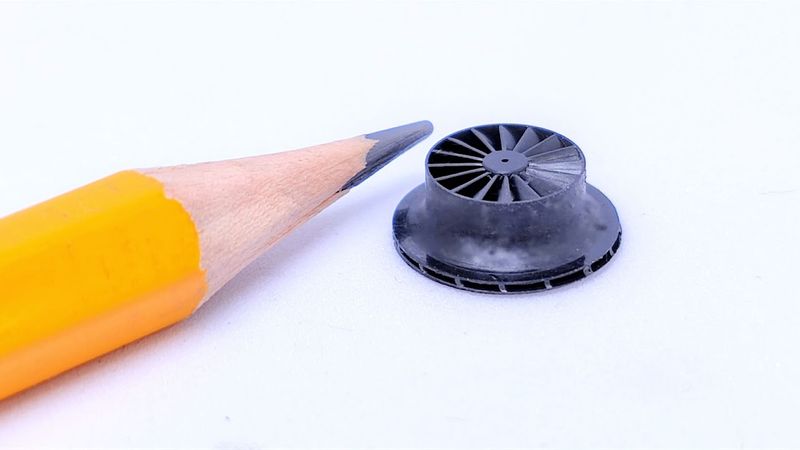Micro Additive Manufacturing challenges the traditional manufacturing status quo
Avi Cohen from Fabrica discusses how Micro Additive Manufacturing can enable cutting-edge innovation.

A tiny complex, 3D printed part.
Micro additive manufacturing (AM) is the creation of tiny parts in lightweight, high performance plastics. This emerging manufacturing field is contributed to by the Fabrica Group who have developed the Fabrica 2.0 micro 3D printer. The printer works on the advanced generation of a Digital Light Processor (DLP) 3D printer and with micron levels of resolution enabling incredibly small parts to be printed. The Fabrica Group have developed their own range of 3D printing materials based on commonly used industry polymers which allow for ultra-high resolution prints. The technology brings AM to applications that require high precision such as aerospace, electronics, automotive, medical, optics, education, and more.
Previously, manufacturing nano components required traditional micro-molding. Due to the requirement for extremely costly and time-consuming micro tools this molding could only occur with extremely high volume runs. The expense associated with this type of micro tooling means that it is only cost-effective when parts are mass-produced in the millions. OEMs requiring prototype, small, or medium volume runs had limited options. The advent of micro AM technology means low volume and prototype parts can be produced cost-effectively, opening the door to more democratic and more efficient product development.
The Executive Vice President of global sales of Fabrica Group Avi Cohen recently sat down with Wevolver to discuss the future of Micro AM and talk more about the Fabrica Group technology.

How does your Fabrica 2.0 micro AM technology manage to attain such tight tolerances?
The Fabrica 2.0 achieves true single micron resolution mass-produced parts across numerous sectors as a result of a range of technological innovations. Hardware-wise, the AM platform uses the digital light processor (DLP) engine, but this is used in conjunction with adaptive optics. In the Fabrica 2.0, once the image is projected through the DLP unit, adaptive optics control various critical optical working point parameters such as focus, tilt, and astigmatism. The DLP unit is also placed on an optomechanical apparatus which facilitates real time corrections of other working parameters, mainly location and accuracy in the XY plane. This apparatus also corrects for degrees of freedom such as wobbling to allow for better surface finish on parts.
In respect of software, feedback algorithms are used in a closed-loop to increase accuracy and repeatability in production. Of particular importance, positioning errors are corrected using laser distance measurements. Another algorithm family is focused on customised file preparation, optimizing print angle, build plate orientation, and supports etc, all to ensure the most accurate, timely, and cost-effective part production.
Finally, we also have considerable in-house materials expertise and have developed proprietary materials (based on the most commonly used industry polymers such as ABS and PP) which enable ultra-high resolution in parts built through modifications in polymerization radii, viscosity, surface tension, and spectral-optical penetration depth.

Why should manufacturers be interested in micro AM?
Well put quite simply, because of the impact the use of AM can have on OEMs looking to produce innovative products economically and in a timely fashion. Through use of the Fabrica 2.0, for the first time micro manufacturers can now realistically assess a shift to AM from conventional manufacturing processes. OEMs can therefore benefit from the inherent advantages that AM offers in terms of promoting part complexity with no increase in cost, eliminating the needs for expensive tooling, reducing part counts and the need for assembly, speeding product development time, easy revision of part design, mass customization, reduction in waste, and reduction in energy costs.
What are the critical things you would like someone to know about the Fabrica Group, the Fabrica 2.0, and micro AM?
First, we want to make it clear that the days have gone when there was a total reliance on expensive and often quite restrictive micro injection molding technologies. The second item of importance is to fully appreciate just what the use of micro AM technology can bring to manufacturers of miniature plastic parts and components. The Fabrica 2.0 throws the window wide open for design engineers to exploit almost limitless design freedom, and so now the process is not the obstacle when it comes to innovation and producing parts that are required but until now have been impossible to make.
Summary
Thanks to the agility and flexibility of AM, hardware designers can invent, test, and develop products from anywhere in the world. The low investment costs mean anyone can be creating the next huge product idea, a domain previously restricted to large OEMs who had the money to invest in expensive prototypes and low-batch production processes.
With new technologies such as the Fabrica 2.0, AM nano-scale parts can be produced at cost and scale that enable companies and engineering teams of any size to develop products in high precision industries such as aerospace. The applications for micro AM are varied and its potential for use cases such as robust sensors, semiconductors, optics, and medical devices will only grow in the coming years.
About the sponsor: Fabrica Group
Fabrica Group is a leader in the field of AM for precision manufacturing. By combining technologies from the semiconductor industry and additive manufacturing the company has developed the Fabrica 2.0, an industrial, high throughput printer with micron resolution. The printer manufactures precise parts as well as high-performance tooling for the injection molding industry. Fabrica Group. We dream big so our customers can print small.

